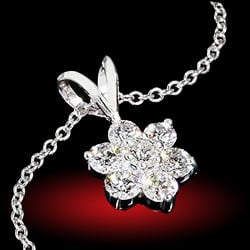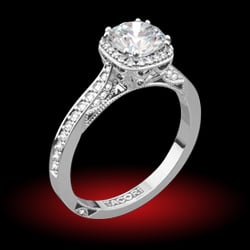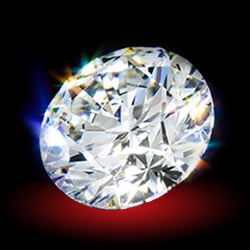You are using an out of date browser. It may not display this or other websites correctly.
You should upgrade or use an alternative browser.
You should upgrade or use an alternative browser.
What does "HPHT HPHT" mean, in the notes section of a report?
- Thread starter Marjan12
- Start date
- Status
- Not open for further replies. Please create a new topic or request for this thread to be opened.
stone-cold11
Super_Ideal_Rock
- Joined
- Sep 9, 2008
- Messages
- 14,083
- Joined
- Apr 30, 2005
- Messages
- 42,064
Date: 7/9/2009 2:37:11 PM
Author:Marjan12
Hi all -
I found one stone w/the comment 'HPHT HPHT' in the notes section. Anyone knows what this means?
Thanks -
High pressure high temperature treatment Marjan and stone-cold.
Here is more info quoted from expert John Pollard.
"The subject of color treatment, from coatings to HPHT to irradiation is a hot topic. When it comes to diamonds, many sellers (ourselves included) prefer not to deal with stones treated to alter their natural color or clarity.
General Electric developed HPHT. It was first used to turn yellowish diamonds into fancy colored diamonds, but now it is also used to improve the color of yellowish-brownish diamonds. In 1999 the GIA began accepting these diamonds for grading. They were involved in research with GE at the time. The Federal Trade Commission requires that HPHT must be disclosed, so GIA notes "HPHT Annealed" or "Artificially Irradiated" on grading reports when it's detected. The diamonds themselves are laser-inscribed with the words "HPHT Processed," "Irradiated" or a specific registered name so there is full disclosure. "GE POL"has been inscribed on Bellataire diamonds. More on GE-processed diamonds
GIA’s reasoning for accepting them is as follows: "...by grading them in the lab, we were able to indicate that they were HPHT annealed on their reports (and on the diamonds themselves). Our “greater good” goal was to protect the trade and the public by protecting the integrity of all diamonds..." Full GIA Article
Whether you are a fan or not, as long as treatments are disclosed it's up to the buyer to decide if it is acceptable and to enjoy wearing the diamond."
Kaleigh
Super_Ideal_Rock
- Joined
- Nov 18, 2004
- Messages
- 29,571
That''s my thought as well.Date: 7/9/2009 2:40:09 PM
Author: Lorelei
High pressure high temperature treatment.Date: 7/9/2009 2:37:11 PM
Author:Marjan12
Hi all -
I found one stone w/the comment ''HPHT HPHT'' in the notes section. Anyone knows what this means?
Thanks -
stone-cold11
Super_Ideal_Rock
- Joined
- Sep 9, 2008
- Messages
- 14,083
- Joined
- Apr 30, 2005
- Messages
- 42,064
We are here for you!Date: 7/9/2009 2:44:57 PM
Author: Marjan12
Thanks Lorelei/John and all -
...How am I ever going to be able to buy anything now w/out my own private list of advisors?!

- Joined
- Jun 29, 2008
- Messages
- 10,261
- Joined
- Apr 30, 2005
- Messages
- 42,064
I believe not with colour treated diamonds.Date: 7/9/2009 11:35:36 PM
Author: iota
Does HPHT affect the integrity of the stone?
stone-cold11
Super_Ideal_Rock
- Joined
- Sep 9, 2008
- Messages
- 14,083
- Joined
- Jan 20, 2009
- Messages
- 1,299
Date: 7/9/2009 2:37:11 PM
Author:Marjan12
I found one stone w/the comment 'HPHT HPHT' in the notes section. Anyone knows what this means?
Yea, it means that the white diamond which you are looking at used to be a yucky hard-to-sell, low value, brown

(that's the really simple explanation)
adamasgem
Brilliant_Rock
- Joined
- May 23, 2003
- Messages
- 1,338
HPHT treatment can either destroy what they call clustered vacancies in type IIa or IaB diamonds, thereby decolorizing them from their original unsaleable brownish hue, remove grayish/browish overtones on FANCY COLORED IIa''s and IIb''s (blues), AS WELL AS create color centers in Type I diamonds to turn them into very FANCY colors like intense yellows, yellow greens, REDS (in combination with irradiation and annealing). There are many articles on my web site Adamasgem Web Site, dealing with the various detection techniques.Date: 7/10/2009 1:04:55 PM
Author: Todd Gray
Date: 7/9/2009 2:37:11 PM
Author:Marjan12
I found one stone w/the comment ''HPHT HPHT'' in the notes section. Anyone knows what this means?
Yea, it means that the white diamond which you are looking at used to be a yucky hard-to-sell, low value, brown
(that''s the really simple explanation)
General Electric first commercialized the product (under the Pegesus (GEPOL) and then Bellataire brands (via Lazare Kaplan) around 2000, but experiment had been going on world wide since the late 70''s (especially in decolorizing IIa''s where DeBeers had admitted publically, before they went private that they had been stockpiling Typp IIa "industrial" browns, because they knew it could be done), and even though GE (who sold off their superabrasives devision, the HPHT component now called Diamond Innovations) held patents here and worldwide, lietterally EVERYONE around the world who had access to High Pressure pressses (typically used for synthesizing diamond) now seemingly overtly or covertly process diamonds for dealers. They have learned so much in the past 9 years or so that they can take unsalable material and create some of the most fantastically colored diamonds in the world, or decolorize brown rough.
At the time prior to the process being public, I had unkowingly sold General Electric, though a third party diamond company, a pair of my SAS2000 systems so that they could monitor the processing effects. And when I said unkowingly, I mean it, with some of the most preeminent GE people having phoney business cards. Interestingly, I put the connection together because of a message delivered (to a now very good friend who was using a phoney name at the time) in the bar at the Cornell Club in NYC, during a training session I was conducting. Nice to work with PhD''s who knew what I was saying, and could easily understand techniques I was demonstrating and limitations I was expaining, very sharp learning curves very different from the typical.
Disclosure is NOW required by the FTC, as we pushed through changes in the regs, mainly because the treatment materially effected the value of the item, and Elly Rosen and I pointed out current NYS business law that was in place at the time prior to the FTC changes requiring disclosure, The FTC regs, seemingly didn''t require disclosure at the time, because the HPHT treatment was permanent, hence it was ammended.
Worldwide, it is a wild west game where literally it is open season for deception (I don''t know what rule the EU has enacted, but ASIA, Africa and the Eastern European countries are open season, and a lot of undisclosed material reaches the US), and even in the US, some don''t obey the disclosure rules, others bribe labs to "miss" the call and some stones still cannot be (at this time), definatively determined as treated or not , and labs like GIA CORRECTLY disclose (for once), when they can determine it with paper that says "ORIGIN OF COLOR INDETERMINATE", phrasiology which has long been associated with the vast majority of GREEN diamonds (which owe their color to naturally occuring radiation), but has been humanly induced since around 1900.
Since the decolorization era, most small independent labs can relatively easily say whether a stone was of a type that COULD HAVE been treated, but it sometimes requires equipment in the six figure cost category to say definately, and then it is not 100% accurate or able all the time. Ambiguity still is there in some cases, especially in very high clarity, D colored diamonds. We have been continually researching, sometimes with cooperation, sometimes not.
An example of such an exercise is given in http://www.adamasgem.org/typeiia.html
- Status
- Not open for further replies. Please create a new topic or request for this thread to be opened.
Share:
The Ultimate Guide to Men’s Wedding Bands: Metals, Fit & Finish
The Ultimate Guide to Men’s Wedding Bands: Metals, Fit & Finish - 06/27
Chipped Diamonds: Causes, Risks, and What You Should Do About It
Chipped Diamonds: Causes, Risks, and What You Should Do About It - 06/27







300x240.png)